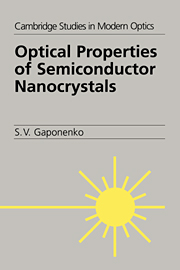Book contents
- Frontmatter
- Contents
- Preface
- 1 Electron states in crystal
- 2 Electron states in an ideal nanocrystal
- 3 Growth of nanocrystals
- 4 General properties of spectrally inhomogeneous media
- 5 Absorption and emission of light by semiconductor nanocrystals
- 6 Resonant optical nonlinearities and related many-body effects
- 7 Interface effects
- 8 Spatially organized ensembles of nanocrystals
- References
- Index
8 - Spatially organized ensembles of nanocrystals
Published online by Cambridge University Press: 09 October 2009
- Frontmatter
- Contents
- Preface
- 1 Electron states in crystal
- 2 Electron states in an ideal nanocrystal
- 3 Growth of nanocrystals
- 4 General properties of spectrally inhomogeneous media
- 5 Absorption and emission of light by semiconductor nanocrystals
- 6 Resonant optical nonlinearities and related many-body effects
- 7 Interface effects
- 8 Spatially organized ensembles of nanocrystals
- References
- Index
Summary
The advances in physics and the technology of semiconductor nanocrystals that were summarized in Chapters 2–7 provide comprehensive knowledge on the optical and electronic properties of nanocrystals and make it possible to create novel mesoscopic materials with desirable parameters by means of stoichiometry and size control. In these chapters the intrinsic properties of nanocrystals were discussed, implying the absence of any cooperative effect on the properties of a given nanocrystal ensemble. In recent years significant progress has been made in moving from randomized nanocrystals towards spatially organized structures like nanocrystal superlattices, quantum dot solids, and photonic crystals. The principal results obtained in the field will be reviewed in this chapter.
Superlattices of nanocrystals: quantum dot solids
There are several ways to develop a nanocrystal superlattice, that is, a structure consisting of identical nanocrystals with regular spatial arrangement. The first is to use zeolites, which form a skeleton with regular displacement of extremely small cages, the size of a cage being typically about 1 nm. A number of clusters such as CdnSm and ZnnSm can be embedded in these cages, the cluster size distribution and geometry being controlled by the topology of the three-dimensional host surface (Wang et al. 1989; Stucky and MacDougall 1990; Bogomolov and Pavlova 1995 and references therein). Using various zeolites as frameworks for semiconductor clusters makes possible the study of regular three-dimensional cluster lattices with variable intercluster spacing.
- Type
- Chapter
- Information
- Optical Properties of Semiconductor Nanocrystals , pp. 203 - 212Publisher: Cambridge University PressPrint publication year: 1998



